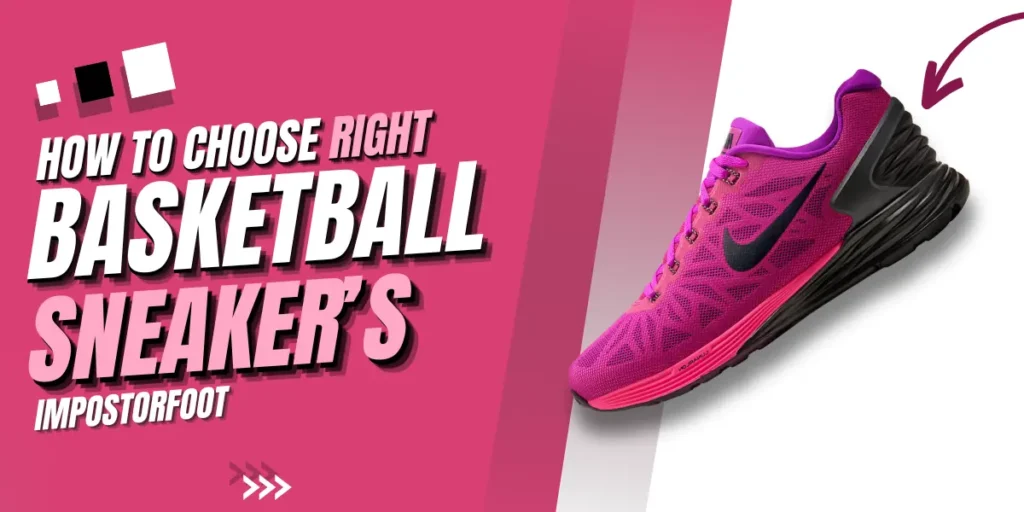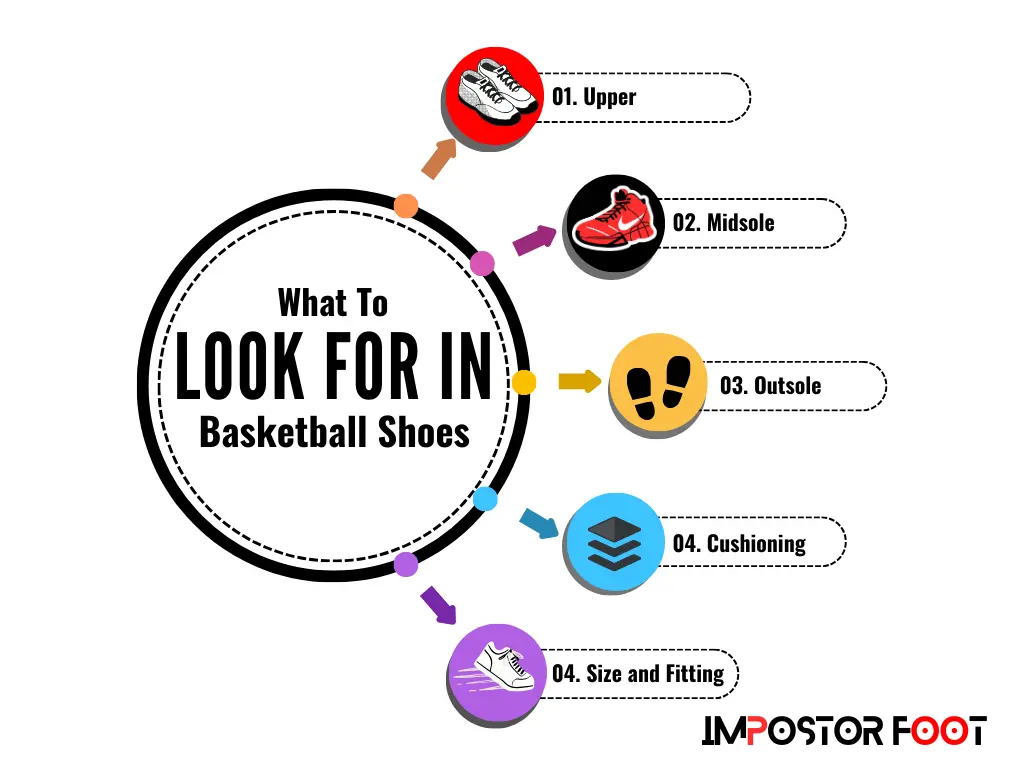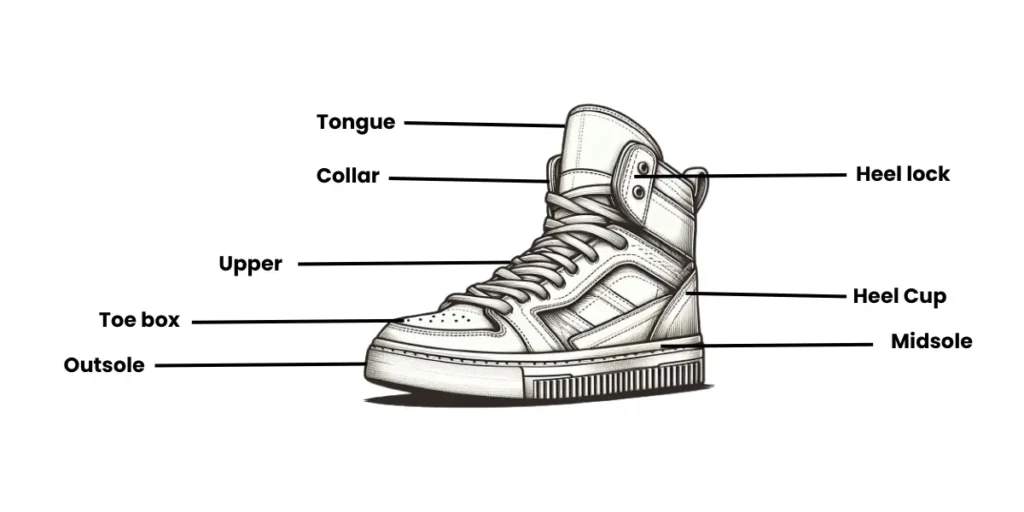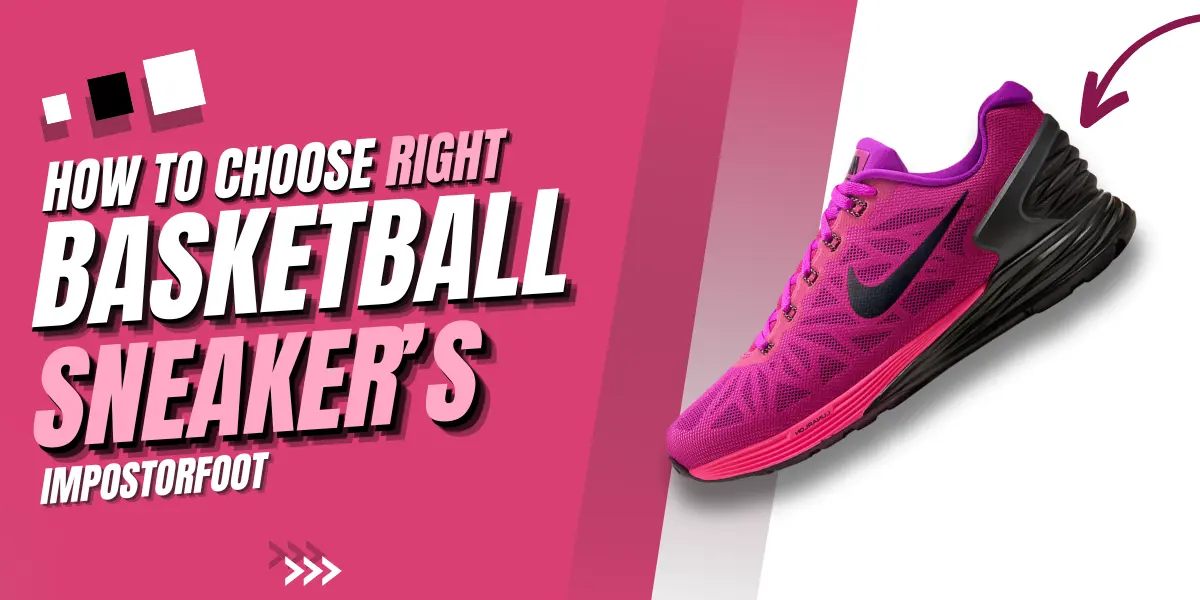
To gain any competitive edge at basketball, pros usually suggest having specialized basketball shoes. But, with tons of options on the market, how do you know if you’re picking the right one for yourself?
That’s why, today, I’m here to help you figure out how to choose basketball shoes for yourself and what essential features you need to look for in your basketball shoes.
Contents
What to Look For?

Basketball shoes are designed with a specific set of modifications in design, weight, materials, soles, and cushioning. These modifications are set up according to the roles of the players in basketball.
For instance, if your role is to be a speedster, then you would need lightweight basketball shoes with moderate cushioning to increase your running speed. And, just like that, other positions also call for specific adjustments that can maximize performance and minimize injuries.
So, when buying basketball shoes, it’s important to be specific about your role and your needs. Only then will you see a boost in your performance. Otherwise, you won’t!
Below, I’ve listed some essential features that pro players usually look for in basketball shoes:
- Upper
- Midsole
- Outsole
- Cushioning
- Size and Fitting
- Heel Lock
- Weight
And here’s a label sketch of basketball shoes for your understanding:

Now, let’s learn how to identify what’s best for you.
Upper
The upper is actually the area that covers the foot. It’s responsible for providing performance, durability, comfort, and support to the player.
On the upper, these are some important elements that should be considered when buying any basketball shoe:
1. Material
Materials can greatly affect both the appearance and performance of athletic footwear.
For your basketball needs, the materials of the upper should be durable, breathable, and flexible. Here’s why:
Basketball is a tough and fast-paced game, so your shoes should have a durable upper to withstand it. The most listed materials for that are synthetic leather, TPU (thermoplastic polyurethane), and reinforced textiles.
With durability, the upper should also be breathable to keep your feet cool and fresh. Mesh and knit fabrics are great materials for this.
Lastly, the material should be flexible to let your feet move naturally without feeling stiff.
Related Article: Are Vans Shoes Good For Basketball Shoes?
2. Support
Typically, the ankle is the main point of support. And speaking of that, there are three types of ankle supports.
- High Tops: High tops give the most ankle support but limited mobility. These shoes offer excellent ankle support and stability. They are also pretty great for those who are injury-prone. However, high-top basketball shoes are usually the heaviest. This can sometimes slow you down. They go best with power-players.
- Mid Tops: Mid-top basketball shoes stop at ankle level and offer a good balance between low tops and high tops. They are ideal for beginners or those unsure about their playing style. Mid-tops are also great for all-rounders who need a bit of everything. However, mid-tops don’t provide as much ankle support as high-tops.
- Low Tops: Low tops provide the least ankle support but are lightweight and offer more mobility. They work well for players who enjoy playing at a fast pace and making quick movements, such as cross-fakes, pass-fakes, and shot-fakes.
With that, basketball involves a lot of side-to-side movement, so the upper should include features like overlays or straps to provide lateral stability as well.
3. Protection
Protection features on the uppers are super important. On the upper, you need to check a few things, like:
- Toe Protection: Reinforced toe caps can protect the toes from impact and abrasions.
- Impact Resistance: The upper should have some cushioning elements to absorb impacts from jumps and landings.
Related Article: Why are Kobe Shoes So Expensive?
Midsole
After having a thorough look at the upper, it’s time to look at the midsole.
The midsole is actually the cushioned section between the upper and outsole. The most common materials for midsoles in basketball shoes are foam and air bubbles.
A good midsole actually provides comfort, flexibility, and impact absorption, reducing stress on the foot during intense gameplay.
To enhance the midsole of basketball shoes further, incorporating advanced materials like responsive gels or smart materials that adapt to the player’s movements could be considered.
But that is all up to you; a normal EVA foam or air-cushioned midsole works just fine for everyone.
Outsole
The outsole is the traction on the bottom of the shoe. In basketball, the outsole needs to have a few features, including:
- Flexibility
- Traction
- Thickness
- Pattern
Flexibility
The flexibility of the outsole or footbend is crucial for peak performance on the court. Flexibility enhances comfort by adapting to natural foot movements and providing a better court feel.
Without flexibility, the risk of injuries is high. So, if you’re serious about the game, try not to buy shoes with stiff outsoles.
Traction
For stability and grip on the ground, the outsole must also provide traction.
Creating more friction on the court is what traction means. In general, it is believed that increased traction correlates with performance since players can lose control when there is insufficient traction.
To get the most traction, companies most often use rubber. It can be either natural or synthetic. Both work fine to provide traction. Rubber is not just great for providing traction for the player but also flexibility.
Thickness
With that, the thickness of the soles also matters. Thin soles are best for indoor wooden courts, while thick soles are better for outdoor use.
Pattern
And one more thing is pattern. The pattern helps to spread the player’s weight evenly across the outsole. It also helps in creating better traction and stability. Thus, it reduces the risk of slipping and tripping.
On a common basis, you get to see two types of patterns.
- Herringbone Pattern: This is a common tread pattern used in basketball shoes. The zigzag design offers multidirectional traction, helping players make quick cuts and changes in direction.
- Circular Patterns: Some outsoles feature circular patterns or other geometric designs to enhance pivoting and lateral movements.
Cushioning
Next up is cushioning, padding, or whatever you call it.
It helps to absorb the shock of landings and reduces the strain on the player’s ankles and knees. With that, it helps you gain flexibility and stability.
It’s a great feature but extra cushioning adds weight, which can make you slow.
Generally, you get to see three levels of cushioning on basketball shoes, and they affect how much shock your legs feel:
- Regular-Cushioned Shoes: These provide less cushioning, so when you land, the shock to your lower legs is higher. But they are more lightweight and allow players to move on quickly. They are good for speedsters.
- Best-Cushioned Shoes: They come with a lot of cushioning. These are the most comfortable, reducing the shock and impact on your legs the most. They’re great for longer jumps, but not so good for running. They go best with power-players.
- Better-Cushioned Shoes: These fall in the middle. They allow for more ankle movement compared to both the best-cushioned and regular-cushioned shoes. They’re best for all-rounders.
Size and Fitting
Find a shoe in your size and check if it fits perfectly. A perfect fit for basketball shoes means shoes should be tight around the foot but loose in the toes.
This means checking that you’re having a snug fit around the middle of your foot and a firm grip on your heel, but a loose grip on your toes.
Once you find a shoe like that, wear it, take a walk, do some jumps, and check if its not extra spacious. Extra spacious shoes are also bad for basketball, as they cause injuries and restrict quick movements.
Finally, identify if any points cause you pain. If not, then you’re good.
Heel Lock
The next feature that really matters in basketball shoes is the heel lock or heel counter. A heel lock is a lacing technique using the extra lacing eyelet to reduce heel slip when running.
Heel lock can be a beneficial technique on a basketball shoe, as all other elements depend on it. For example, you can’t take advantage of cushioning without a proper heel lock. Securing your heel into the footbed allows you to fully benefit from the heel cushioning, which is crucial for absorbing impact.
Additionally, a locked-down heel prevents the foot from sliding back and forth, blistering, and chafing, reducing toe jams and hot spots. It also stops the foot from sliding side to side, which can cause ankle rolls and injuries.
So, whenever you’re shopping for basketball shoes, my advice is to prioritize finding a pair with a heel lockdown feature.
Weight
The weight of the shoes also impacts the performance of the player. The lighter the weight, the more responsive the player gets. On the other hand, heavier shoes provide better cushioning and stability.
In the game, lightweight shoes help players move quickly, make rapid cuts, or change directions quickly. With that, these shoes also reduce the effort needed to lift the feet. These shoes help players conserve their energy and minimize their fatigue throughout the game. Moreover, these shoes also improve jumping ability, allowing players to make higher jumps that benefit shooting, rebounding, and blocking shots.
And, most importantly, lightweight shoes play a vital role in injury prevention. They reduce the impact on joints and muscles. They decrease the likelihood of injuries related to overexertion and strain.
Similarly, heavier shoes also come with some advantages, like providing more impact absorption on longer jumps. They do cause fatigue but they make sure the player’s feet stay cushioned all the time.
So, yeah! Weight management is a player’s personal choice.
Do the Asthetics of Basketball Shoes Matter?
Looks or asthetics do not help improve your performance. However, the basketball shoe aesthetic has a different significance, such as a psychological boost.
Wearing shoes that you find stylish and appealing can boost your confidence and make you feel more motivated on the court. Feeling good about your gear can help you perform better and have a more positive attitude.
So yeah! Though not directly, it does matter.
Pick Basketball Shoes By Positions and Play Styles
You might have learned how to choose your own basketball shoes. Let us take a look at what kind of shoes will be best for each position in a basketball game
1. Point Guard (PG)
The point guard is often the team’s primary ball handler and playmaker. These guys are responsible for running the offense, distributing the ball, and setting up plays.
For this position, you need lightweight shoes with excellent traction and support for quick cuts and movements. Low-top or mid-top shoes will be great for this point, as they allow for good mobility.
2. Shooting Guard (SG)
The shooting guard is typically the primary scorer, especially from the perimeter. They need to be good at shooting, driving to the basket, and defending opposing guards.
For shooting guards, find some shoes that could offer support for both shooting and driving. I mean, shoes that are lightweight, have mid-top ankle support, and have better cushioning to absorb impact will work well for this post.
3. Small Forward (SF)
Small forwards are flexible players who can score from both inside and outside, defend multiple positions, and often act as secondary ball handlers.
Small forwards need balanced shoes that provide mid-top ankle support, better cushioning, and good traction.
4. Power Forward (PF)
Power forwards play both offensively and defensively. They engage in a physical game, often acting as strong rebounders and mid-range shooters.
Shoes for this position should have the best cushioning, hi-top ankle support, and a lightweight design.
5. Center (C)
Centers are typically the tallest players on the team. They play near the basket on both offense and defense. They focus on scoring in the paint, rebounding, and shot-blocking.
Shoes for centers need to provide hi-top ankle support, the best cushioning, and durability to handle the rigorous demands of playing in the post.
Final Words: Are Basketball Shoes Worth Buying?
Yes! They are definitely worth buying.
Remember, every detail matters in a basketball game, especially in the final seconds, when the game can be won or lost. So, to perform at your best, it’s crucial to own basketball shoes. They offer the player significant advantages in terms of support, traction, comfort, and performance. And not having one actually gives your opponent an advantage.
That’s why putting your money on a quality pair of basketball shoes is never a bad idea. If you’re serious about the game and your health, buy the right pair of basketball shoes.
FAQ
Can You Wear Any Shoes for Basketball?
You can wear any shoes you want, but wearing any shoes won’t give you a competitive edge in basketball. If you want an extra boost in performance, it’s best to get yourself a good pair of basketball shoes.
Remember that basketball shoes are made specifically for the sport. They provide cushioning and support to protect your ankles, feet, and knees from injury. They also help you move more quickly and confidently on the court. Regular shoes don’t provide such features, so pros don’t suggest playing in them.
Do Shoes Matters in Basketball?
Yes, shoes matter significantly in basketball for several reasons.
They provide essential support, cushioning, and traction, which enhance performance and reduce injury risk. The right basketball shoes offer support and stability to handle the sport’s frequent lateral movements, jumps, and quick direction changes, thus preventing injuries like sprains.
Proper cushioning is essential for absorbing the impact of running and jumping and protecting the feet and joints from stress and fatigue. With that, you get traction, which is another crucial factor; the outsole of basketball shoes is designed to provide grip on the court, preventing slips and enhancing quick movements.
Thus, buying quality basketball shoes will always depend on one’s playing style and foot type, which is crucial for optimal performance and injury prevention.
Are Basketball shoes Heavy or Light Better?
Lightweight shoes are often considered best for playing basketball. Lighter shoes allow for quicker movements, making it easier to sprint, change direction, and jump. Reduced weight can help decrease fatigue during prolonged play, allowing players to maintain energy levels.
However, heavy shoes also come with some advantages, like being more durable and providing more cushioning. They are also quite stable, which can be beneficial for players who perform a lot of physical, aggressive movements.
So, it all depends on what type of play style you have.




